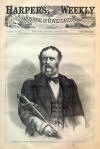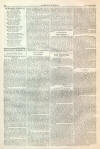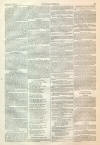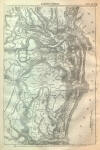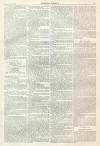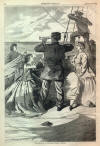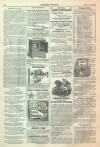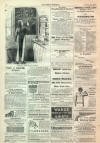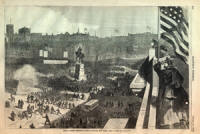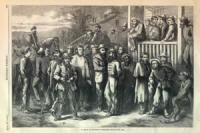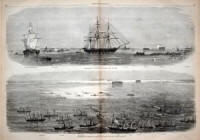The Ericsson Devil
|
|
This Site:
|
THE IRON-CLADS AT CHARLESTON.ON pages 264 and 265 we publish two views of Charleston Harbor—one from the Battery, looking seaward, and showing Fort Sumter in the distance; another from our blockading fleet, showing the entrance to the harbor, with our iron-clads just over the bar. The following narrative of the attack of 7th is from the officers of the Keokuk: The fleet, after leaving Hilton Head, rendezvoused in the mouth of the Edisto. Several days were occupied in gathering the vessels and making final arrangements—issuing orders and otherwise arranging for the great combat. All being completed, the fleet left in detachments, and assembled off Charleston on Sunday, the 5th instant. The iron-clad fleet crossed the bar and entered Charleston Harbor on Monday. The Keokuk, drawing less water than any of the others, was sent in first, to find the channel and replace the buoys. Proceeding up the main ship-channel, the Keokuk found an easy and unobstructed entrance, with full eighteen feet of water in the shallowest places—more than has ever before been on Charleston bar. The buoys were replaced without difficulty, the rebels offering no opposition. The Keokuk returned to the fleet, and on the morning of the 7th the order was given the iron-clads to enter the harbor. The order was to proceed in single file, or in line ahead. The Weehawken was the leading vessel, having in front of her a scow, and then between the scow and herself Ericsson's torpedo exploder, or "devil," as it has been called. The Ironsides, with Admiral Dupont on board, was the fifth in line, and the Keokuk the last. In this order the bar was passed in safety, without detention. The order given to the commanders of the various vessels was to keep on straight up the harbor until they were within one thousand yards of the forts, and then to attack, directing their efforts principally against Fort Sumter. In this order the fleet moved on steadily and gallantly up toward Forts Sumter and Moultrie, the rebels withholding their fire until they got well up into the harbor. The Ironsides stopped off Fort Moultrie, and let go her anchor, it being dangerous to take her farther up on account of her drawing over fifteen feet. At this moment there seemed to be a temporary misunderstanding, and all the iron-clads, except the Weehawken and the Keokuk, gathered about the Ironsides, apparently supposing that she had grounded and needed assistance. They were, however, soon signaled to go into action. The Keokuk had kept inward until she led the line, and had advanced to within four hundred yards of Fort Sumter, against whose granite walls she hailed her heavy shot with all the rapidity that the energy of her brave crew could furnish. The rebels, as was expected, immediately concentrated their fire on the Keokuk, which assumed to lead in the attack. From Sumter, Moultrie, Batteries Beauregard on Cummings Point, and from a fort erected on the middle ground, the fire of four or five hundred guns were concentrated in a terrible hail upon the devoted vessel. Such a fire had never, perhaps, in the history of the world been equaled. It was met by the officers of the Keokuk with heroic fortitude, while the balls were striking her at the rate of one every second. Her guns were worked with vigor and precision, and their weight and force were already making their mark upon the walls of Sumter. THE ERICSSON DEVIL AND "WEEHAWKEN."DECK PLAN.A, Ericsson Battery.—B, Turret.—C, Pilot-house.—D, Smoke-stack.—E, Raft or Devil.—F, Lock String. — G, Infernal Machine. It soon, however, became apparent that she had none of the impregnability of Ericsson's Monitors—that, in fact, she was a failure. The rebel balls seemed to penetrate her as easily as if a wooden vessel. The port-holes or shutters of her turrets became jammed and her guns practically unserviceable. During the thirty minutes she remained under this concentrated fire one hundred shot struck her, ninety of which were water-line shots, or such as would cause her to leak in a seaway. In fact, she was perfectly riddled. Her flag was shot into tatters and the whole of her sides battered, bruised, and pierced. Perceiving the severe injuries she had received, the Admiral signaled her to retire out of action and anchor beyond range. This was safely accomplished. In the mean time the Monitors Nahant and Catskill had moved up to the support of the Keokuk, and engaged Fort Sumter. The Ironsides and other vessels at longer range were dividing their attention between Moultrie and Sumter. Into and on the latter fort a heavy fire was thus poured, and, it is believed, not without effect. The engagement was kept up from one until four o'clock, when, in obedience to the Admiral's signals, the fleet retired slowly, receiving and returning the rebel fire until they anchored out of range within the bar. The Weehawken was assigned the important duty which was faithfully performed in the midst of the fight, to examine, and, if possible, to fire the obstructions which the rebels have extended across the harbor from Fort Sumter to Moultrie. Protected by the scow and the "devil" in front of her, she pushed straight up toward the obstructions. They were found to consist of a net-work of chains and cables stretched across the harbor, over which it was impossible for the Weehawken to run without fouling her propeller, and which she found it impossible to force. To the net-work the rebels are supposed to have suspended torpedoes and other submarine explosives. Having completed examination, and tested the impossibility of working up the harbor until means are devised for the removal of these obstructions, the Weehawken returned and reported to Admiral Dupont, who ordered a discontinuance of the conflict. It is believed that the damage done to Fort Sumter by our fire was serious. So far as it showed externally it consisted in two embrasures being knocked into one, and numerous indentations in the wall, which, it is believed, a few hours more pounding would convert into a serious breach. What damage or loss of life was sustained in the interior of the fort is not, of course, known, but it is believed to have been considerable. Fort Moultrie was also well hammered, and at least one gun was dismounted. Beyond the sinking of the Keokuk, the damage to the iron-clads was very slight, not more than would require twenty-four hours to repair. They all came out of the contest in fighting trim, and able to have continued the conflict lad it been desirable. The Ironsides was hit frequently, but besides having one port shutter injured was unharmed. Our informant heard of no serious casualties on board any of the vessels except the Keokuk. This vessel sunk next morning, about one thousand yards fron Morris Island beach. She had thirteen wounded, two of whom, including Acting-Ensign Mcintosh, will probably die. The "devil" was not lost, as stated by the rebel dispatches. When the Weehawken returned from the reconnoissance of the obstructions, the scow she had in tow broke loose and grounded off Morris Island. The rebels, thinking it a dangerous affair, peppered away at it, thinking it was the "devil," or something worse. A, Raft.—B, Torpedo-catcher.—C, Battery.—D, Infernal Machine. THE IRON-CLAD "KEOKUK" ON THE WAYS BEFORE LAUNCHING.—[SEE PAGE 267.]   |
||||||||||||||||||||||
|
|
||
|
|
Site Copyright 2003-2018 Son of the South. For Questions or comments about this collection, contact paul@sonofthesouth.net |
|
|
Are you Scared and Confused? Read My Snake Story, a story of hope and encouragement, to help you face your fears. |
||
